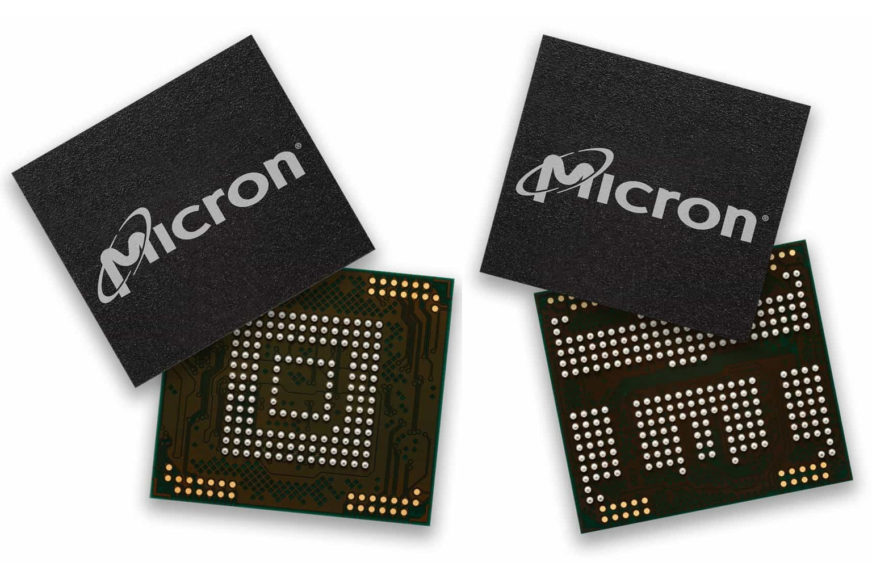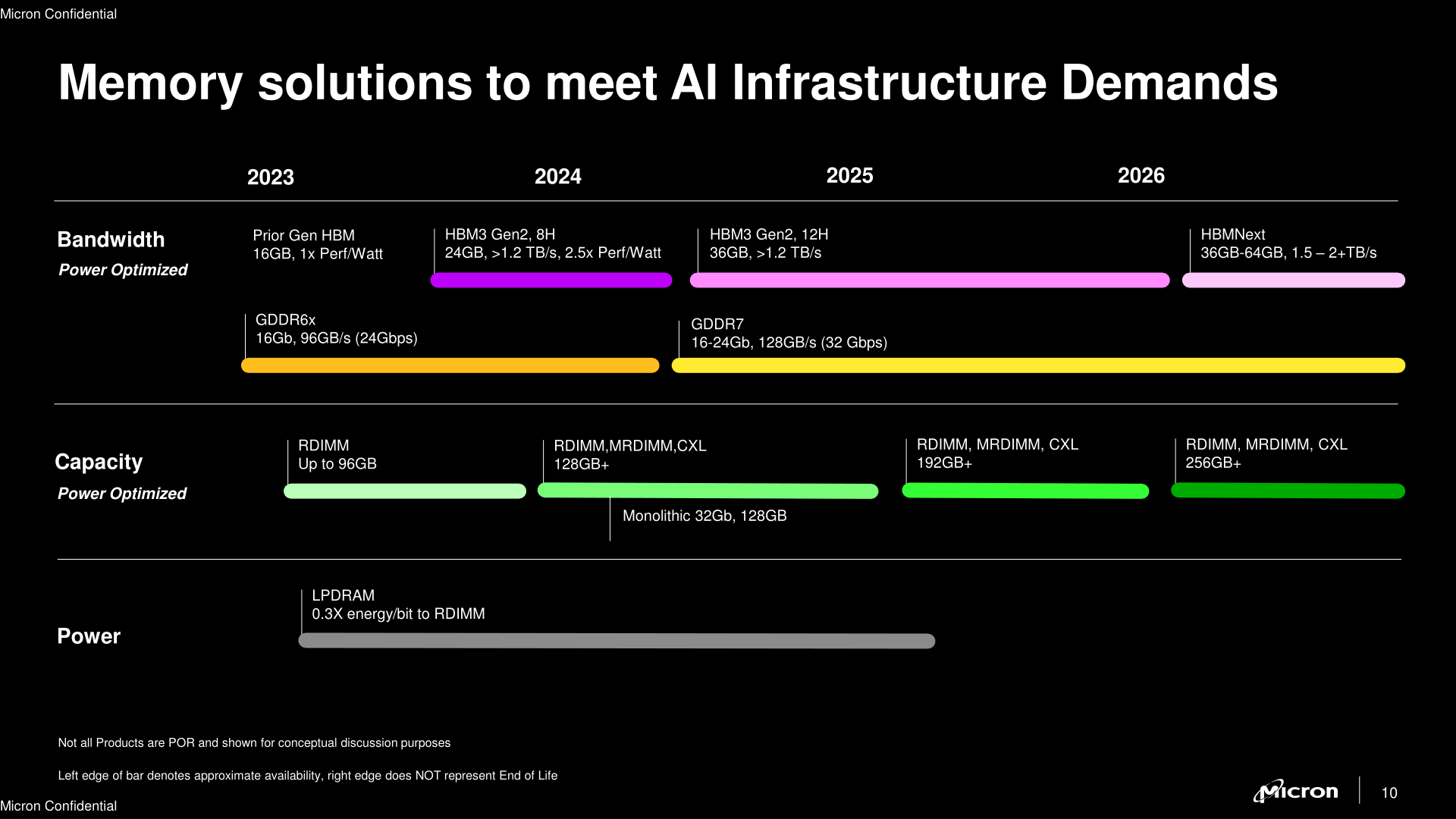Micron is planning higher memory chip capacities. Big promise in 24Gb GDDR7 dies
With the GeForce RTX 4060 Ti 16GB, there has been discussion that most GPUs won’t get double memory capacity until larger chips come to market. But that seems to be happening. Micron’s roadmap how shows higher capacity DRAM chips. These will be larger DDR5 chips, which will enable 256GB RAM sizes in a regular PC. But there are also plans for larger GDDR7 chips, which will allow memory capacity on graphics cards to be raised.
Micron unveiled a roadmap of DRAM, i.e. random access memory for PCs and related memory such as GDDR and HBM, used mainly in GPUs and similar accelerators. There’s more than one interesting thing in this announcement. Starting with high-performance GPU memory, Micron indicates that a new generation of HBM technology is expected to come into production in 2026. It doesn’t have a name yet and is only labeled “HBMNext”, probably also because the standard in question is not yet announced. However, it could probably end up being HBM4. This memory should have a capacity of 36–64 GB per package (likely 12 layers of 3 GB in the first case and eight layers of 8 GB in the second case). Bandwidth is supposed to be 1.5–2.0 TB/s per package or higher, so a GPU with six packages would have a bandwidth of over 12 TB/s…
Larger memory capacity for next-gen graphics cards
However, what is probably more important to us is cheaper GDDR-type graphics memory. Micron’s roadmap shows that GDDR7, the next generation, which was also recently announced by Samsung, is due to go into production in 2024. But probably in the second half of it (this may be related to the fact that Nvidia is said to have delayed the next generation of graphics cards until 2025). Same as Samsung’s, Micron’s GDDR7 is supposed to run at an effective “frequency” of 32.0 GHz.
But what is interesting are the capacities. GDDR7 will be produced in a base capacity of 16 Gb (2GB) and likely no lower. This is the same capacity that is the maximum and now predominantly used capacity in the current GDDR6 generation. It allows you to fit 8GB on a graphics card with a 128-bit bus, 12GB on a 192-bit bus, 16GB on a 256-bit bus, and so on. With clamshell mode, where there are twice as many chips, double capacities are then possible, which is the case with the RTX 4060 Ti 16GB, but that’s not used often.
But on top of that, 24Gb GDDR7 chips are also going into production, for which the effective capacity would be 3GB per chip. And that will allow for graphics cards with 50% more memory capacity. So in addition to the previously cited numbers, it will also be possible to have 12GB graphics cards with a 128-bit bus, 18GB graphics cards with a 192-bit bus, 24GB graphics cards with a 256-bit bus, or a capacity of 36GB for GPUs with a 384-bit bus width. A clamshell design would double those again.
This opens up the possibility for next-generation graphics cards to get more memory. A jump of just 50% will mean that the cost of increasing memory capacity won’t be as prohibitive as it would be if the jump was straight up to 32Gb/4GB chips. So hopefully AMD and Nvidia will be a bit more willing to use these larger chips. It should also be convenient that there won’t be as big a distance between the two possible graphics cards configurations. Today, for example, the dilemma with the GeForce RTX 4060 Ti is that either the card has 8GB, which is considered low, or they jump straight to 16GB with twice as many chips, which is a lot in terms of manufacturing costs and arguably this large capacity could be already excessive for the card. With 24Gb chips on the market, the options would be 8GB and 12GB (and 16GB/24GB with clamshell mode). Mainstream graphics cards will hopefully jump to 12GB, on the other hand models with wide buses will still be able to use smaller chips (24GB for 384bit GPUs for example) so that they don’t end up at a price disadvantage due to “too big” memory.
128GB memory modules for desktop and laptops
But PC main memory (RAM) is also set to improve. Micron reveals in the roadmap that it is preparing 32Gb (4GB) DDR5 chips. These would be in addition to the 16Gb (2GB) and 24Gb (3GB) capacities that are available currently and should be in production by 2024.
This means that the capacity of DIMM modules for PCs will be able to reach up to 32 GB for a regular single-sided module and 64 GB for a double-sided (and dual-rank) module. So it will be possible to fit 256 GB of RAM in desktop boards with four slots, or 128 GB in mini-ITX boards with just two slots. Similarly, SO-DIMM memory capacities for laptops should also increase like this. The possibility to fit 128 GB (in two modules) will probably be quite interesting for notebooks used for serious work and compute uses, if of course the user works with such demanding software (Chrome and applications based on the Electron library, for example).
But of course, these higher capacities will be expensive. RAM prices haven’t been exactly falling rapidly over the last two decades, so while our options have improved tremendously over last 15 years, it’s mostly of use it if you have a generous budget for your system.
Source: AnandTech
English translation and edit by Jozef Dudáš
⠀









